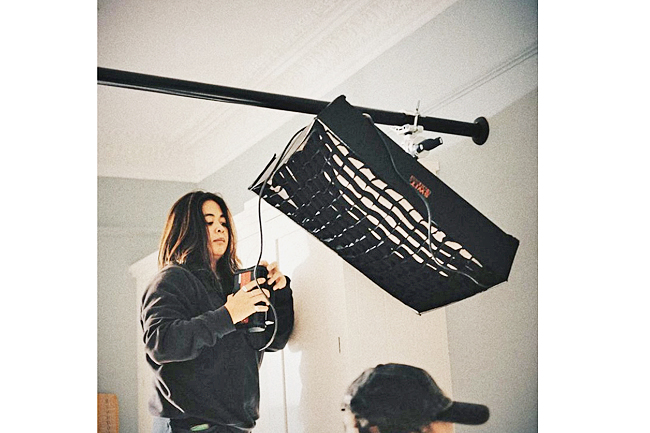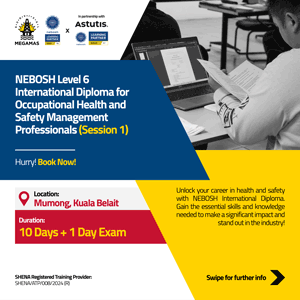The journey of one Bruneian woman in the male-dominated world of lighting.
We’re in a dimly lit living room; a large ceramic pot sits comfortably on an oval glass dining table. Twenty-six-year-old Bruneian Atikah Zainidi, clad in a black T-shirt and jeans, pulled a sleek device from her tool belt and inserted it into an electrical socket.
It’s a tool to measure voltage. An LED light stand is perched nearby to illuminate the ceramic ornament. As she examined the readings, her face lit up a smidge with comprehension.
“There’s no power in the wall socket,” said the filmmaker-turned-gaffer before plugging her lighting equipment into a new socket. Then with just a flick of a switch, the room was flooded with bright, white light.
A LUMINOUS FORCE
Atikah looks like your average youth; she has a proneness for dark clothing, a passion for food, is an avid rock climber and is generally a laidback individual.
However, as a female gaffer who has worked for international film and television sets, freelancing for companies, the likes of the Discovery Channel and VICE, in what is traditionally seen as a male-dominated field, her life is anything but ordinary.
“A gaffer is the head of the lighting department, which works under the director of photography (DoP) or cinematographer,” explained Atikah in an interview with the Bulletin.
As a graduate of the University of the Arts London (UAL) in the United Kingdom (UK), Atikah is well aware of the lighting department’s important role in any set, even though the masses often overlook it.
“Think about how lighting can change a scene completely. Take a woman sitting outside on a park bench. What if we added some hard light onto it? Where’s this scene going?
“What if we added some accents of red? Is it a horror? Is it a mystery? If we added some nice soft lighting, it could be a romance. So yeah, I think lighting is very important.”

A FLICKER IS BORN
Careers are squiggly, she imparted when asked how her lighting journey began. Despite her youth, Atikah has developed many talents and with it comes many hats.
In the industry, she is most known for her work in lighting. However, she is a Jill-of-all-trades.
She is a director, producer, and photographer, and with a background in culinary, she is a chef in her downtime.
One passion stood out from the rest; filmmaking. Hence in 2015, the budding film artist enrolled at UAL as a film and television undergraduate, where she first dipped her toes in the world of lighting.
“I did quite a bit of side gaffing (at UAL), helping out friends with their major projects. They’d ask me if I wanted to gaffe their films and me not knowing what a gaffer was, I said yes, thinking that the job only involved turning on a light.
“At that point, I felt like I knew everything about the lighting world. I thought I knew all the lights needed for a set just because I did a few major projects.”
It was an off-the-cuff notion borne from ignorance. After several years in the industry, Atikah fully understands how gaffing goes beyond merely flipping a light switch. A fact that was made abundantly clear as she recalled one of her first paid gaffing gigs.
“Everyone was there with their tool belts and tool pouches, just filled with all of these tools (and) I showed up with my BND2 pocket knife. (At that point) I was like, oh, I have a lot to learn.”

BRIGHT LIKE A DIAMOND
After graduating from UAL in 2019, she found herself in Indonesia, directing and producing short documentaries for VICE. Her line of work in lighting took a backseat during this chapter of her life.
Fortunately – or unfortunately – for Atikah, her stint in Indonesia was cut short due to the pandemic, forcing her to return home to the Sultanate just a year later.
It was supposed to be a two-week stay, but the country had implemented a lockdown. Consequently, she stayed in Brunei and worked as a chef. Still, by the end of 2020, the young auteur returned to the UK to continue her Master’s.
And amid her postgraduate course, Atikah landed an official lighting project, a commercial shoot for a luxury retailer specialising in fine jewellery.
It was an opportunity that presented itself when she met Benjamin Leggett, a freelance cinematographer she befriended during a film project she was assisting in.
“He told me I should be doing more lighting and gave me my first gaffing job.
“It was this huge diamond (and) I was nervous, it was my first time (officially) gaffing and we had problems; the lighting set-ups weren’t working, but we had a small space and a limited budget.”
A probe lens was used for extreme close-up shots of the diamond, which, according to the then-fledgling gaffer, was a tall order, especially for an object that can shift and refract light with the slightest disturbance.
“It was crazy, but we did it and the clients were happy.”
Since then, she was taken under Leggett’s wings and was mentored on the ins and outs of lighting.
She was given first-hand experience as she was brought on to gaffe projects that Leggett was involved in.
“It took me a while to progress to where I am now, where I always get called for gaffing work. I was fortunate that I had the most supportive friends who all work in the industry.
“People took their chances on me, and eventually, I just built a name for myself because the other thing was, there are not that many female gaffers in the world, so that did come to my advantage sometimes, she said”
Primarily working in the UK, she admitted that some opportunities may have been brought on due to the novelty that Atikah brings on set as a female Southeast Asian gaffer adding: “It’s a double-edged sword because diversity is in now, but you know what, that is fine.”
ILLUMINATING INSIGHTS
After working on sets in the Eastern and Western hemispheres, Atikah has had a lot of experience, from knowing the different lighting requirements of each country to familiarising herself with the different electrical metrics of the other continents.
“It’s interesting to compare them all because if we go to the basic technical stuff. For instance, the UK and France are so close, but the terms for certain equipment change drastically; a stand in the UK is called a turtle, but can be called a spider in France.”
The different electrical systems in particular, pose an interesting challenge for Paris-raised Bruneian, as it reflects the potential dangers of the gaffing job.
As a senior or lead lighting tech on film sets, gaffers have to ensure that not only specific lighting needs are met but that all the lights are safely rigged.
“The job is dangerous. Not only do we deal with electricity, we have to change the lighting set-ups often, so sometimes we have to climb up on the equipment to adjust the light because it’s quicker. These equipment are also very heavy and hot.”
With all the physical demands of the occupation, Atikah noted how her field is still male-dominated, even in the UK, but things are improving.
“When I first entered the scene five years ago, there was just nothing, but now there are societies, workshops just for women to get into lighting or tech roles.”
In comparison to the industry in Southeast Asia – which she describes as a “cowboy country, every man for himself” – the presence of women in lighting and tech positions is still scarce.
“It’s mad, but I still learn a lot from working here.
“There needs to be a bit more structure and encouragement.”

LIGHT AT THE END OF THE TUNNEL
Despite the industry’s resistance, Atikah still believes that there is a need for more women in lighting. In the UK, she founded a production company that trained people of colour from underrepresented backgrounds, mainly women.
She’s hoping the same can be done in Brunei and the region, and she is imploring more Bruneian women to enter lighting and tech.
“As Bruneians, we are quite lucky that the community is small, so you can email local production companies and see what you can do to gain experience.
“Mahakarya Institue of the Arts Asia is also great. They have all the lighting equipment you need, but aside from that I guess, start with short-form first and a small team, get the hang of it and see how things work. Understand all the roles needed for the job and then, you get out there (and then) it just gets a
lot easier.”
Currently, Atikah is based in Singapore, working for a digital publisher focusing on authentic stories from Southeast Asia, and hoping to create food documentaries exploring its more cultural aspects.
This time around, she’s back behind the camera but unlike last time, lighting is no longer something she could walk away from. “My friends said it’s perfect for me. I’ll be producing and directing, so I’m sad to leave the lighting world. But I love lighting, I love food and I love documentaries.
“I’ll just have to make sure that every documentary I make (moving forward) is well-lit.” – Wardi Wasil






